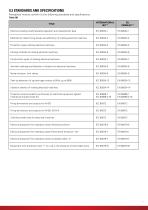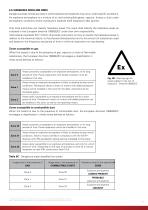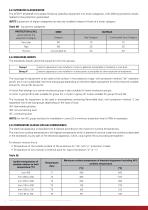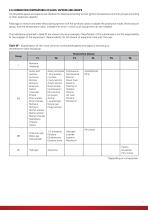
Catalog excerpts

PRODUCT CATALOG INDUSTRIAL HAZARDOUS AREA ELECTRIC MOTORS IE1, IE2, IE3, IE4 JULY 2022 | GLOBAL
Open the catalog to page 1
TABLE OF CONTENTS (Click on each page title below to navigate the page.) SI units and conversion equations Engineering formulae for motor drives Standards and specifications Protection against explosions in dangerous areas Efficiency IE1, IE2, IE3, IE4 Range of motors Common main characteristics Main options Nomenclature Installation and applications Low temperature version and anti-condensation heating Materials, painting and nameplate Shaft ends, balancing, vibrations, noise level coupling and belt drives Brake motors Bearing system Permissible radial loads on the shaft with standard...
Open the catalog to page 2
0.1 SI UNITS AND CONVERSION EQUATIONS Table 0A Description Unit symbol Unit name Angular velocity Angular acceleration Pressure Mechanical stress Work done Thermal quantity 9.81 Nm = 1 kgfm 1 Nm = 0.102 kgfm Watt Dynamic viscosity Kinematic viscosity Electric current Electric voltage Electric resistance Electric conductivity Electric capacity Magnetic flux density Magnetic field strength Magnetic flux Temperature difference
Open the catalog to page 3
0.2 ENGINEERING FORMULAE FOR MOTOR DRIVES = power input = ͞ U • I • cos ϕ • √3 • 10 -3 [kW] = power output = P1 • η [kW] Where: U = voltage [ V ] I = current [ I ] cos ϕ = power factor η = efficiency Power requirements of some applications Lifting: P = m • v • 9.81 • 10-3 [kW] η Rotation: P = M • n [kW] 9550 • η Fan and pump drives: P = H • Q [W] η Where: P = power [kW] m = mass [kg] v = speed [m/s] n = rotational speed [min-1] η = efficiency M = torque [Nm] Q = output [m3/s] H = head [N/m2] Torque from motor power M = 9550 • P2 [Nm] n Where: P2 = motor output [kW] n = motor speed...
Open the catalog to page 4
0.3 STANDARDS AND SPECIFICATIONS Flameproof motors conform to the following standards and specifications: Table 0B TITLE INTERNATIONAL IEC®* Electrical rotating machines/rated operation and characteristic data Methods for determining losses and efficiency of rotating electrical machines Protection types rotating electrical machines Cooling methods of rotating electrical machines Construction types of rotating electrical machines Terminal markings and direction of rotation for electrical machines Noise emission, limit values Start-up behaviour of squirrel-cage motors at 50Hz up to 660V...
Open the catalog to page 5
0.4 PROTECTION AGAINST EXPLOSIONS IN DANGEROUS AREAS 0.4.1 TYPES PROTECTION The use of an electrical apparatus in potentially explosive atmospheres is quite usual today. This equipment has to be manufactured in such a way that there is no risk of explosion. An explosion occurs when of the three following conditions happen: • Presence of a potentially explosive atmosphere; • Possibility of transmission of the explosion; • Existence of an ignition source. The recognized types of protection eliminate one of these conditions and thus make an explosion impossible. Protection methods for GAS Two...
Open the catalog to page 6
0.4.2 DANGEROUS AREAS AND ZONES Dangerous areas include any area in which explosive atmospheres may occur under specific conditions. An explosive atmosphere is a mixture of air and combustible gases, vapours, fumes or dust under atmospheric conditions where combustion expands itself (explosion) after ignition. Only local authorities can classify hazardous areas. The users shall classify the hazardous areas as indicated in the European directive 1999/92/EC under their own responsibility. International standards IEC®* 61241-10 provide instructions on how to classify the hazardous areas in...
Open the catalog to page 7
0.4.3 APPARATUS CLASSIFICATION The ATEX®* 2014/34/EU European Directive classifies equipment into three categories, with differing protection levels, related to the protection guaranteed. NOTE: Equipment of higher categories can also be installed instead of those of a lower category. Table 0D - Equipment categories PROTECTION LEVEL guaranteed by the equipment Category Combustible Dust Category Very high 0.4.4 ENCLOSURE GROUPS The standards classify electrical equipment into two groups. Group I electric apparatus to be installed in mines or galleries susceptible to firedamp or coal dust....
Open the catalog to page 8
0.4.6 COMBUSTION TEMPERATURES OF GASES, VAPOURS AND GROUPS Combustible gases and vapours are divided into classes according to their ignition temperature and into groups according to their explosive capacity. Markings on motors and other electrical equipment with the symbols used to indicate the protection mode, the enclosure group, and the temperature class, indicate the zone in which such equipment can be installed. The indications contained in table 0F are shown only as an example. Classification of the substances is not the responsibility of the supplier of the equipment. Responsibility...
Open the catalog to page 9
0.4.7 TEMPERATURE FOR ATMOSPHERES WITH COMBUSTIBLE DUSTS The flash point of the dust must be taken into account in providing protection against flammable dust, in both the cloud form and in layers. The surface temperature of the enclosure indicated on the motor nameplate must be less than the reference ignition temperature. The reference temperature is the lowest between the two values thus calculated: TS1 = 2/3 Tcl (Tcl = ignition temperature of the cloud of dust) TS2 = T5mm – 75K (T5mm = ignition temperature of a 5mm layer of dust). Tamm = lowest between TS1 and TS2. Dust ignition...
Open the catalog to page 10
0.4.7 LEVEL OF PROTECTION FOR THE EQUIPMENT (EPL, EQUIPMENT PROTECTION LEVEL) In accordance with standard IEC®* EN 60079-0 the marking of equipment to be used in a potentially explosive atmosphere must also have the suffix EPL. EPL is defined as the level of protection assigned to electrical equipment based on the probability of it becoming a source of ignition. The EPL also makes it possible to distinguish between the different explosive atmospheres. The first letter makes the following distinctions: M The second letter gives information on the probability of becoming a source of ignition:...
Open the catalog to page 11All Cemp S.r.l. catalogs and technical brochures
-
EXPLOSION PROOF BRAKE MOTORS
6 Pages


